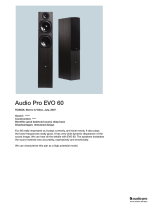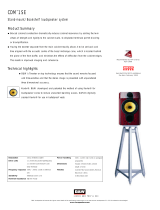
5
Many A/V processors feature delay settings. The purpose of delay is to enable surround and dialogue information to arrive at the listener’s
ears at the same time as the front channels, even when the listening seat is in a non-ideal position. On some processors, this can be
achieved by setting the distance from the listening position to each speaker, but other systems allow only a time delay setting.
Rear Delay: If the listening position is equidistant from the front and rear speakers, set a low delay setting. The closer the listener is to the
rear speakers this higher the delay setting used should be.
Centre Delay: If the centre speaker is level with (or slightly behind) the front speakers, set the delay to zero. If the centre speaker is forward
of the front speakers, increase the delay.
LFE: In the cinema the low fr
equency e ects channel is an extra bass channel with its own subwoofer. In domestic systems the LFE channel
typically feeds into the subwoofer. Where no subwoofer is used, the LFE signal is combined with the front channels and sent to the front
speakers. When you set the LFE level at your A/V processor, use care as powerful low frequencies can overload domestic loudspeakers.
If you hear popping or thumping noises coming from the front loudspeakers or subwoofer, immediately turn the A/V processor’s volume
level down and then lower the LFE level. This should cure the problem. If it does not, lower the volume level at the subwoofer (if you are
using one) until the problem disappears.
Phase: Plea
se read the relevant sections of your A/V a r manual and familiarise yourself with the various issues. If you are unsure,
consult your dealer for help. A home theatre system should have a precise front stage, a d use rear stage and good localization of
dialogue. If the colours on the loudspeaker terminals do not correspond with those on the r, the sound will appear poorly focused
or ‘out of phase’. For this reason it is essential that the speakers are connected according to the wiring diagrams in this manual.
Connecting loudspeakers correctly (in phase) is essential whether the system is stereo or multichannel. This is especially important if you
are bi-wiring – if only one element in a bi-wired system is incorrectly connected (out of phase), the e
ects can be very noticeable yet hard
to pinpoint.
Delay and LFE Settings
Setting Loudspeaker Sizes and Levels
If you are not using a subwoofer: Set the Front speakers to ‘Large’. Set the ‘Subwoofer’ option on the processor to ‘ ’ or ‘No’. The Front
channels will now receive all the system bass.
If you are using a subwoofer: When set to ‘Small’ all the system bass will go into the subwoofer. If you choose ‘Large’ the Front channel bass
will be reproduced from the Front speakers. Follow the instructions on this page for suitable size and crossover settings.
Once the loudspeaker settings have been put the A/V r into its ‘Test’ mode (see instructions supplied with your
processor). Adjust the level of each channel until all channels are reproduced at equal loudness.
On some programme material the surround channel may seem lower in level than the front. Do not readjust this level. You may, however, need to
adjust the subwoofer output level. Avoid setting too high a level or you will swamp the sound with bass. This can be tiring to listen to, and
may limit the subwoofer’s ability to respond to large bass transients. You should also set a sensible level going into the subwoofer from the
A/V processor. Start with the subwoofer volume control set to between 12 o'clock and 3 o'clock.
Before investigating a problem, always switch o
the system at mains.
If your system is not working properly please work through this checklist before returning the unit to your dealer.
Troubleshooting
Symptom Possible Cause
No Sound System not switched on; Speaker cables shorting terminals out; Wrong source selected
Sound lacks bass content Subwoofer not switched on
Lack of bass reproduction Subwoofer phase incorrect; Subwoofer crossover control too low
Excessive bass distortion at low volumes Subwoofer set to high; LFE level set too high; Subwoofer incorrectly wired
Excessive or distorted bass at high levels System level set too high; Bass control set too high; Subwoofer too close to room corners
Distorted / rattling sound at high levels System level set too high; Objects too close to subwoofer
Popping or thumping from the subwoofer System level set too high; Subwoofer level set too high; LFE level set too high


















